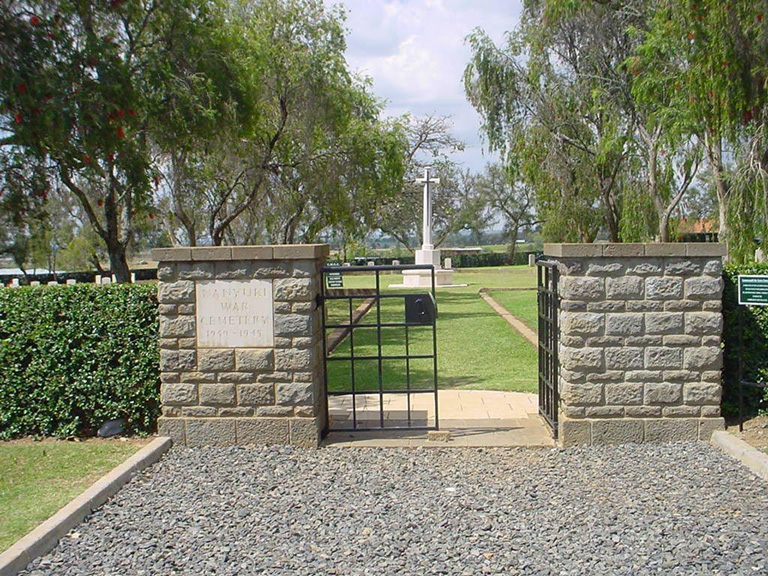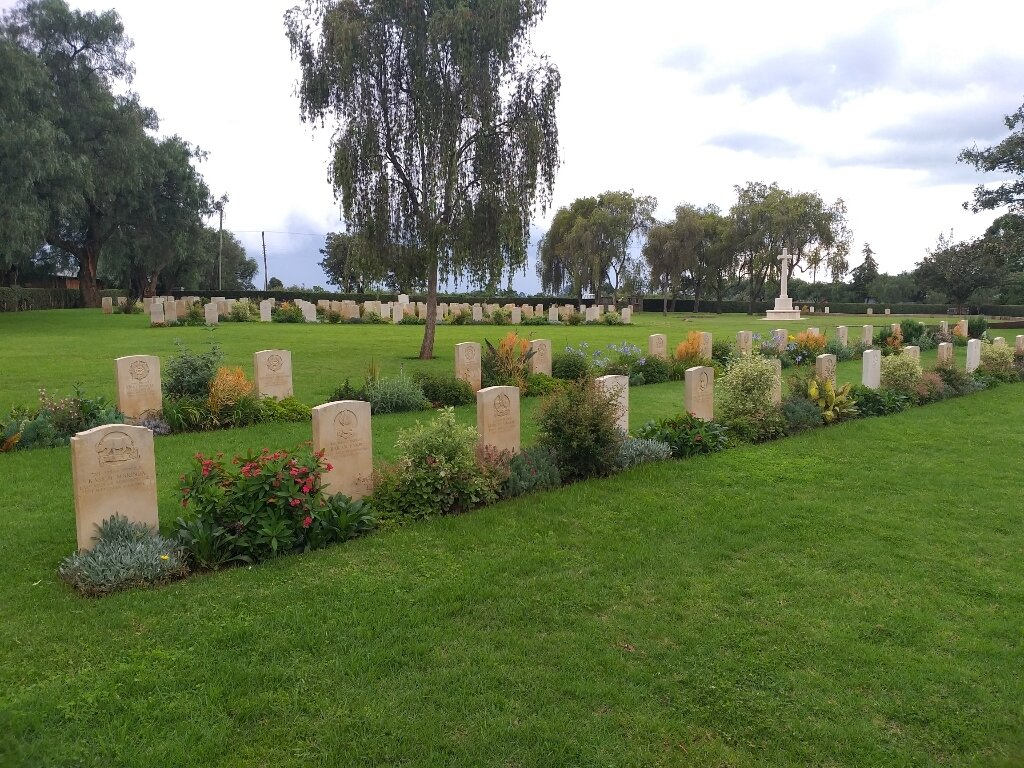Nanyuki War Cemetery
- Country Kenya
- Total identified casualties 200 Find these casualties
- Identified casualties from Second World War
- GPS Coordinates Latitude: -0.00053, Longitude: 37.10035
Cemetery Spotlight: Nanyuki War Cemetery

The beautiful Nanyuki War Cemetery contains more than 200 war graves of soldiers from across East Africa who died in the Second World War. There are also 36 non-war burials and 1 Abyssinian war grave in the cemetery.
It was established in February 1940 when Nanyuki was a strategic rail head for the advance into Ethiopia and a key base for the Royal Air Force, and a site was needed to inter soldiers who died in hostilities in East Africa
Among the burials here are the headstones of four airmen of the SAAF (South African Air Force) who crashed on Mt Kenya on the 23rd July 1942. The wreckage of Blenheim Z7763 lay undiscovered in dense bamboo forest until 2002, when it was found by the British Army Training Unit Kenya (BATUK) at an altitude of 10,000 feet. It was subsequently confirmed by experts to be the missing aircraft.
On March 23, 2017, the CWGC hosted a service to remember the lives of:
• Pilot: Second Lieutenant Charles Herbert Allen Born 21 April 1915
• Navigator: Second Lieutenant Hendrik Jacobus Petrus (Bookie) Lemmer Born 21 May 1919
• Air Gunner/Wireless Operator: Air Sgt Lloyd Murray Born 6 March 1917
• Air Gunner/Wireless Operator: Air Sgt Simon Eliastam Born July 1921
who were lost during a training flight on July 23, 1942.
It took several years to organise a joint return operation to the remote location in 2016, which led to the confirmation of the wreckage and deaths.

Many of our sites have the environmental conditions for horticultural features such as trees, turf and flowers to thrive without too much difficulty.
However in the past few years, climate change has seen a steady decline in rains, or resulted in erratic rainfall patterns that cannot adequately sustain horticultural features without necessitating irrigation, or that leave a trail of damage of turf and border plants from flooding or uprooting huge ancient trees that have formed part of the vista of CWGC cemeteries from the time they were constructed.

We regularly survey the trees here to check their structural integrity and their risk of collapse, and implement appropriate remedial measures as needed. Staff are encouraged to report all extreme weather events as soon as they occur.
In addition, there is a focus on selecting drought-tolerant plant species, particularly for border plantings, to reduce the need for supplemental irrigation.
We have drilled boreholes in most of the full horticultural sites in the region, thereby avoiding reliance on the municipal water supply and ensuring year-round irrigation of features; however, when the boreholes are depleted, priority is given to border plants.
Our staff and contractors are given regular horticultural training to equip them with the knowledge and skills to propagate new plants from their mother plants, ensuring that damaged plants can be replanted promptly.
We use local plant varieties that have lower water requirements than imported plants and use the smallest possible amount of chemicals to minimise our impact on the environment. We also recycle our green waste by composting them in silos then re-using them as manures.

For Nanyuki, the biggest challenge we face is the loss of plants every rain season. The cemetery gets flooded by water from the upper side of the cemetery resulting in death of plants from waterlogging. Gardeners, James and Florence understand how to divide and replace the missing plants.
Another challenge is the presence of very old Schinus Molle trees, most of which have branches overhanging the roofs of neighbouring houses. Our staff check the trees every morning for any signs of deterioration at the start of each workday, because they understand the impact a broken branch falling on a house.
Location information
Nanyuki is located about 165 kilometres north of Nairobi, on the north-western side of Mount Kenya.
The Cemetery is about 4 kilometres along a rough road from the town centre. From Nanyuki's shopping area turn right onto the road to Mount Kenya Safari Club. The cemetery is down the road on the left hand side, set well back with the grassed entrance drive marked by boundary stones. The route is signposted from the centre of town.
Visiting information
ARRIVAL
The route to the cemetery is signposted.
PARKING
It is possible to park along the access track, which leads to the cemetery from the main road.
The ground is flat and firm, the surface is loose gravel aggregate. The distance is approximately 15 metres from the main entrance.
ACCESS, LAYOUT AND MAIN ENTRANCE
The main entrance is approximately 2 metres wide, with a double gate opening inwards into the cemetery. There is a small stone gate stop in the centre of the entrance opening.
The main entrance paving is a semi-circular area bound on either side by raised stone kerbs, approximately 10 cm higher than the entrance paving.
All the internal paths are grass, the ground is flat and firm. There are raised stone kerbs creating corridors leading to the Cross of Sacrifice in the centre of the cemetery and to the different plots. The ground adjacent drops off up to 50 cm from these kerbs in certain areas.
The cemetery is a square shape with smaller burial plots spaced around the cemetery.
The Register Box is at the main entrance gate, built into one of the main gate pillars on the inside of the cemetery.
There is a wooden bench located at the rear of the cemetery.
ALTERNATIVE ACCESS
There is no alternative public access to the cemetery.
ADDITIONAL INFORMATION
The cemetery is open from 0600 hrs to 1800 hrs every day. Outside of these hours the entrance gates are padlocked for security.
Normal working hours are as follows: Monday to Friday 0830 hrs to 1200 hrs then 1330 hrs to 1630 hrs.
For visitors arriving outside normal working hours please call the CWGC (Commonwealth War Graves Commission) administrative office on (00254 202604301) for the padlock access code.
History information
During the Second World War, Nanyuki was the rail head for the advance into Ethiopia, via Isiolo, Marsabit and Wajir, and was also an important advance base for the Royal Air Force.
The war cemetery was started during hostilities by the Army, the first burial taking place in February 1940. In 2008 the nearby Civil Cemetery burials were transfered here.
Nanyuki War Cemetery now contains 196 Commonwealth burials of the Second World War. There are also 36 non-war burials and one Abyssinian war grave in the cemetery.




